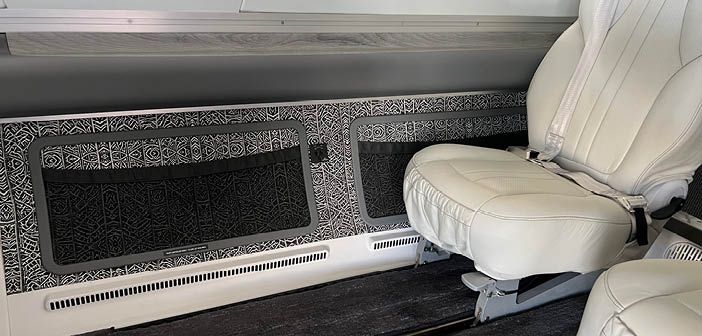Artificial intelligence is now at everyone’s fingertips, but should designers be concerned, or is it just a new tool to master?
There are now artificial intelligence (AI) programmes freely available whereby a layperson can type in whatever scene they might want to see – say, ‘a small business aircraft interior with cosmos design elements; dark colour palette; luxury finish; four VIP seats around a table’ – and an image will be generated. The image may have weird, Escher-esque quirks and lack adherence to aviation requirements, but it could be an interesting image none-the-less. Is this something designers should be worried about? Or, in their skilled hands, could this be an exciting new tool?
Sylvain Mariat, head of creative design and concepts at Airbus Corporate Jets, is interested in its potential. “I’m not afraid about AI; it’s like the debate we had with robotics years ago,” he says. “It could be a supportive tool if we keep people behind it.”
Practical support
One potential application is in the design of a galley, says Mariat, where future AI programmes could perhaps be used to optimise ergonomics or the use of space. “When we design a new aircraft interior, the storage is very important, so this could bring a lot of data on what we need to store,” he adds. “It could also be used to help a designer perfect aircraft weight and balance, or define the lighting inside the cabin.”
Mariat believes there will always be a need for a human designer to add those aspects that really enhance design, recounting a project where he pleasantly surprised a client by incorporating little details inspired by something they mentioned months previously.
“You could use it as a tool and then the designer has to make the final decision,” Mariat comments. “When a designer has a lot of factors going on – a lot of possibilities and a lot of constraints – using AI could be of interest.”
Mixed results
AI image generation works by amalgamating visuals. Jay Beever, vice president of Embraer Design Operations, notes it is an interesting new way to see how ideas, brands and design languages can be merged. “Recently, some of my team members on the industrial design side, building future designs, looked at each other and said, ‘Should we show Jay?’” he begins. “They had been experimenting with an AI tool and were joking about being nervous to show me, because the results were so good.”
They had typed in, ‘Show me Lamborghini meets office chair meets eVTOL’, and the programme had created four designs. “You can pick one, hit ‘refine’ and it’ll go through another loop. You can add in extra words, and it refines it,” says Beever. “In the end they went away from the Lamborghini car, but ended up with four beautiful chair designs that looked potentially viable.”
Idea generator
“So where does it help?” Beever continues. “Whether it comes up with a beautiful design or not, it provides a head start to ideation; helping you find your way through good form design and shapes. You can find inspiration in a detail you hadn’t thought of, and then on your own, you refine it into what you want.”
AI users should check the tool’s terms of service to discern if images can be commercialised. How would Beever react if someone created a design incorporating elements of Embraer design language? “I think I’d be flattered; imitation is the sincerest form of flattery,” he says. “I think that happens anyway. We’re all inspired by other peoples’ products, and then we find a different way to build something new. If it was a true carbon copy of what we have, that would be different.”
Past projects by Embraer – for example the Duet collaboration with Porsche – have involved a similar blending of design languages, but this was achieved by human designers in a considered collaborative process, with all the details that are so important in creating a luxury design. Beever emphasises that humans are vital in the design process.
“With the AI design I referenced, it became like a playground to develop something further without AI, organically, with the human engineering in the details and doing the industrial part,” he explains. “There are some out there who will let the AI create the images to a certain point and then publish it as their own. We see it as a starting point. We look for inspiration in nature, automobiles and furniture, and figure out where all those things come together to make an aircraft interior. AI is now just helping us do it in another way.”
Surprise and delight
Is there a danger in further allowing algorithms – which work by processing things already in existence – yet more control over human output? “There’s actually inherent long-term flaws in letting AI design,” says Beever. “It’s only going to be able to source from what somebody has provided on the internet. So does that, in the long term, dilute the real genius of human creativity? It’s not going to have that X-factor, emotion. Sometimes design comes out of emotion and AI is not going to be emotional.”
However, Beever thinks AI could develop its own kind of creativity: “In the long run, this beast will have had so many different people say so many different things that inevitably it’ll end up growing on its own.
We might see a reduction in what we need to tell it to get to a certain point; it will have learned.”
Custom fabric
In the here and now, there are some immediate ways to put AI to use. For example, First Class Aerospace,
an aircraft interior and paint specialist based in Florida and Georgia, recently worked with a customer to design a custom fabric using AI. Clearly such an application is a much simpler affair than designing a 3D interior, let alone an airworthy one. The company also tried using AI for a paint scheme, but Steve Purello, CEO, noted “the results so far were far less impressive”.
The fabric however, for the lower sidewalls on an Eclipse 500A, has been a success. The firm used Open AI Dall-E 2 to generate the pattern, and then had the fabric created by a third party.

Iterative process
“We asked the programme to make a repeating pattern of the letters ‘F’ and ‘C’ for ‘First Class’ and were interested, but a little disappointed with the results,” explains Purello. “Then we asked it to make an interlocking pattern of the letters; then a repeating interlocking pattern; then a repeating, interlocking geometric pattern. The results began to be promising. Next, we invited our customer into the design centre
and asked them some more questions. Our customer asked us to use all of those terms, but then instead of
the letters we tried ‘Jesus’. We tried repeating the design but it didn’t repeat very well. Finally, we mirrored it, which flips it in four directions, then repeats it, and the magic appeared! It looked nothing like Jesus, but made some intricate and beautiful patterns. Many who have seen the patterns now can see very interesting symbolism like fishes, but it really looks like a beautiful complement to our customer’s overall design for his jet.”
Changes ahead
Purello thinks there will probably be some unanticipated consequences, both good and bad, from the use of AI in the industry: “We’ll have to see what the implications of creating a custom design will be with regards to IP.”
However, overall, Purello is excited by the possibilities. “I think the primary benefit of using AI is the creativity and speed it delivers,” he says. “Within a matter of seconds it’s making suggestions that may have taken weeks for human help to provide. We are really looking forward to what the future of AI holds for us in the aircraft interiors industry.”
This feature was written by Izzy Kington and first published in the September/October 2023 edition of Business Jet Interiors International.





